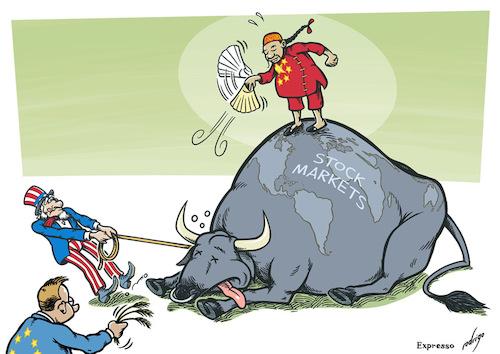The U.S. economy finds itself in a perplexing state of stagnation, caught between rising tariffs and volatile Wall Street dynamics. As trade tensions reshape global markets and investor confidence wavers, economists and policymakers grapple with what many are calling a “stuck economy.” This article explores how tariffs are influencing supply chains and consumer prices, while fluctuating financial markets add layers of uncertainty to economic recovery efforts, painting a complex picture of America’s current marketplace challenges.
The Impact of Tariff Policies on Economic Growth and Market Stability
Tariff policies have long been a double-edged sword in shaping economic dynamics. While proponents argue that tariffs protect domestic industries and preserve jobs, the broader consequences often ripple through the entire market ecosystem. These protective measures can lead to increased production costs, reduced competitiveness, and ultimately, higher prices for consumers. On Wall Street, uncertainty around tariff impositions triggers stock volatility as investors reassess the risk-to-reward landscape of impacted sectors. The tension between safeguarding local economies and encouraging global trade remains a critical balancing act, with policymakers navigating an unpredictable economic terrain that demands flexible yet decisive strategies.
Key effects of tariffs on the economy include:
- Disrupted supply chains causing delays and increased costs
- Shift in investment patterns toward less tariff-affected industries
- Potential retaliation triggering trade wars and market instability
| Economic Indicator | Before Tariffs | After Tariffs | Percentage Change |
|---|---|---|---|
| Manufacturing Growth | 3.2% | 1.1% | -65.6% |
| Consumer Price Index | 1.7% | 2.8% | +64.7% |
| Stock Market Volatility (VIX) | 15.3 | 23.7 | +54.9% |
In addition to immediate economic disruptions, tariffs can undermine long-term market stability by fostering an environment of uncertainty. Businesses delay or alter investment decisions due to unpredictable trading conditions, which dampens innovation and growth prospects. Meanwhile, global trading partners may respond with retaliatory measures, intensifying market friction and eroding international cooperation. As these policy decisions reverberate through both domestic and global economies, navigating tariff impacts demands not just reactive measures but strategic foresight to safeguard economic resilience and restore confidence in volatile markets.
Analyzing Wall Street’s Response to Prolonged Economic Stagnation
Wall Street’s reaction to the persistent economic slowdown has been a blend of cautious optimism and strategic recalibration. Investors are grappling with the pressure of tariffs that have disrupted supply chains while also eroding corporate profit margins. Financial analysts note a shift in portfolio allocations, with a noticeable increase in defensive stocks such as utilities and consumer staples, while high-growth tech equities demonstrate heightened volatility. Market sentiment is further clouded by uncertainty over trade negotiations and fiscal policy interventions, prompting major firms to adopt hedging strategies that buffer against extended stagnation.
Several key factors shape Wall Street’s stance amid this prolonged stagnation:
- Tariff Uncertainty: Trade tensions have injected unpredictability, impacting global investment flows.
- Corporate Earnings: Earnings reports reveal cost pressures and cautious guidance.
- Interest Rate Policies: The Federal Reserve’s stance remains pivotal in calibrating risk appetite.
| Sector | Q1 2024 Growth | Market Volatility |
|---|---|---|
| Utilities | +2.1% | Low |
| Technology | -1.5% | High |
| Consumer Staples | +0.8% | Moderate |
Strategies for Reviving the Economy Through Trade Reform and Financial Innovation
To kickstart sustained growth, policymakers must pursue a multi-faceted approach that intertwines trade liberalization with disruptive financial technologies. Reducing tariffs and dismantling protectionist barriers can unlock new markets for domestic producers, while fostering competition that drives innovation. Meanwhile, embracing fintech advances such as blockchain-based payment systems, peer-to-peer lending platforms, and digital currencies can increase capital accessibility for small and medium enterprises-often the backbone of economic recovery-thus fueling new business creation and job growth.
These elements work best when integrated with clear regulatory frameworks that balance innovation with consumer protection. The following table highlights key strategies alongside their potential impacts on economic revival:
| Strategy | Expected Benefit | Key Challenge |
|---|---|---|
| Tariff Reductions | Expanded export opportunities | Domestic industry pushback |
| Fintech Adoption | Enhanced capital flow | Regulatory uncertainty |
| Deregulation of Markets | Increased investment activity | Risk of financial instability |
- Enhance cross-border data flows to facilitate seamless financial transactions and trade analytics.
- Promote targeted innovation grants aimed at startups focusing on export-driven technologies.
- Strengthen public-private partnerships to harmonize trade reforms with technological advancements.
Future Outlook
As the economy grapples with persistent challenges, the interplay between tariffs and Wall Street dynamics continues to shape the broader financial landscape. Understanding these factors is crucial for policymakers and investors alike as they navigate a complex and often unpredictable market environment. While solutions remain elusive, ongoing dialogue and analysis will be key to addressing the barriers that keep the economy “stuck” and paving the way for more sustainable growth.
